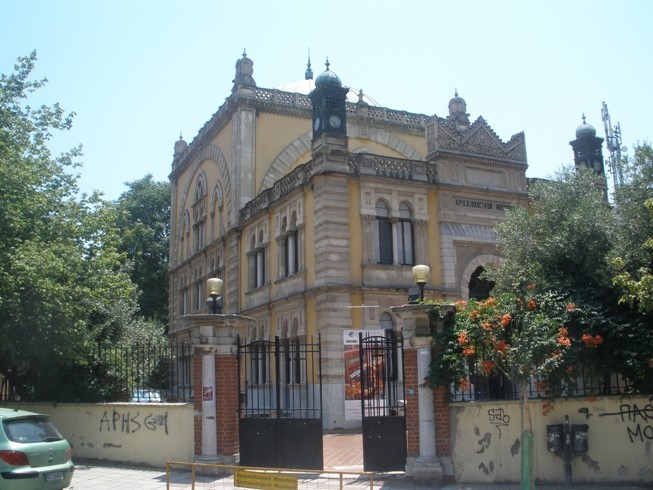Amidst the archaeological wealth of the ancient city of Salonica (modern-day Thessaloniki), the greatest attention is devoted to structures from the Classical and Byzantine periods, which are clearly marked on maps, signposted on-site, and extensively covered in tourist guides. By contrast, structures from the Ottoman period – witnesses to the city’s Jewish and Islamic heritage – are usually overlooked. One such building, shrouded in mystery yet architecturally unique, seems to have vanished from public awareness. It is difficult to locate it in modern Thessaloniki, with little publicly available information and no signage to inform visitors of its history or original purpose.
This neglect is hardly surprising. The building, known as Yeni Djami, once served as a place of worship for one of history’s most enigmatic sects. To followers of other faiths, they were the Dönmeh; to themselves, they were Ma’min. To understand this building, one must first explore the extraordinary history of the sect it represents.
The Jews of Salonica
When Christian forces seized the last Moorish stronghold in Spain in 1492, both Muslim and Jewish populations were expelled. Most Muslims settled in North Africa, where their descendants would rise as formidable pirates, to strike terror into European ships and coastal settlements for centuries. The Jews, on the other hand, found refuge in the most religiously tolerant empire of the time – the Ottoman Empire. A particularly large number of them arrived in Salonica, where, in the city’s remarkably diverse ethnic and religious landscape, they constituted a relative, and at times even absolute, majority until the tragic wars of the 20th century.
Later, Thessaloniki’s Jewish community was joined by the Marranos – Jews who had initially converted to Catholicism to avoid persecution on the Iberian Peninsula but had continued to practise Jewish rituals in secret. Yet, the deep suspicion of both the wider population and the Inquisition meant that, over time, the ever-present fear of pogroms drove them as well to the cities of the Ottoman Empire, with Salonica among their preferred destinations. Though they were, at that point, officially Christians, they had little choice but to embrace Judaism in their new homeland – only to be met with scepticism from the “true” Jews.
And yet, before long, things would grow even more complicated…
The Messiah
In the 17th century, Sabbatai Zevi, a gifted Kabbalist from Smyrna (modern-day Izmir), proclaimed himself the Messiah. When his Kabbalistic calculations were confirmed by another renowned kabbalist, Nathan of Gaza, the news spread like wildfire, and the resulting fervour reached extraordinary proportions.
He embarked on a series of promotional journeys across the Ottoman Empire, trailed by devoted followers and stirring controversy and division wherever he went. His visit to Salonica left a profound mark on the city’s Jewish community, which became sharply divided into supporters and opponents.
At first, the Ottoman authorities remained indifferent, but as Zevi’s movement grew, so did their concern. Matters escalated when a rival (another fellow wannabe-messiah) accused him of plotting to overthrow the Empire. The authorities could no longer ignore him. Killing Zevi outright would have made him a martyr, which could have strengthened the movement and potentially destabilised the Empire. Instead, they presented him with an ultimatum: he could either be executed immediately – if he was truly the Messiah, let him rise from the dead and save the world – or he could convert to Islam and receive a monetary reward.
Faced with this stark choice, Sabbatai Zevi opted for worldly comforts. In the fateful year of 1666 – when, according to Kabbalistic prophecy, he was supposed to redeem the world – he publicly announced his conversion to Islam.
The Ottoman authorities kept their promise: Zevi was granted a state pension, and for a time, he still made public appearances, issuing ambiguous statements before withdrawing into seclusion. He spent his final years in Ulcinj, where he died in 1676 under unclear circumstances. A few years later, on a journey through Skopje, his would-be prophet, Nathan of Gaza, also passed away.
For Zevi’s followers, his conversion was nothing short of a cosmic catastrophe, forcing them into an agonising dilemma. Some, devastated, admitted their mistake and returned to traditional Judaism. Others, while remaining Jewish, continued to worship Zevi in secret – perhaps even to this day. A third group, particularly strong in Salonica, remained steadfast in their loyalty and followed his example, converting to Islam under the belief that it was a temporary, tactical manoeuvre – one that no one truly understood but whose purpose would reveal itself in time. This last group became known as the Dönmeh – a term with pejorative connotations, though we may also call them the Sabbateans after the founder of their movement. It is worth noting that a typical Sabbatean family underwent a remarkable series of transformations: they were originally Jews in Spain, then converted insincerely to Catholicism as Marranos, later reluctantly returned to Judaism, then wholeheartedly embraced Zevi’s teachings, only to convert once again – this time to Islam, insincerely but willingly.
The Dönmeh in Salonica
The Sabbatean sect could only survive in the long run in Salonica, a city where the legacy of religious tolerance from their former homeland – Al-Andalus, Moorish Spain – was still alive. Though initially scorned as heretical apostates, they gradually gained acceptance as a distinct, indigenous religious group, with all the rights that status granted. Religiously, the Islamic framework gradually gained prominence over the Jewish foundation, and in time, their faith came to incorporate both Islamic and Jewish elements in equal measure, with a particularly strong emphasis on shared mysticism.
In a curious way, time worked in their favour. The Sabbateans thrived economically, with many amassing great wealth and building grand, lavishly decorated mansions. Perhaps their long-standing tradition of shifting between religious identities had instilled in them a kind of religious relativism. Whatever the reason, by the 19th century, they had become pioneers of Europeanisation, education, and liberal thought, transforming Salonica into the most progressive and liberal city in the Ottoman Empire. Their involvement in the Young Turk movementwas significant – so much so that the first Young Turk government included three Sabbatean ministers. Even Mustafa Kemal Atatürk, the founder of the Turkish Republic and a native of Salonica, though not of Sabbatean descent, attended a Sabbatean school – the finest and most forward-thinking institution in the city.
Thus, in one way or another, the transformed Sabbateans played an active role in the very events that ultimately led to the fall of the Ottoman Empire and the birth of the Republic. Some even see this as the final fulfilment of Sabbatai Zevi’s mission.
The Last Echo of Former Glory
The wars of the 20th century fundamentally transformed Salonica. The city became part of Greece, and following Greece’s military defeat in Asia Minor, a forced population exchange took place. The Sabbateans, as a form of Muslims, were officially designated as Turks and, in 1923, expelled to Turkey. Despite having no linguistic, ethnic, or historical ties to the Turkish people, this proved to be a fortunate turn of events. Had they remained in Thessaloniki, they would have been annihilated in the Holocaust two decades later. In neutral Turkey, however, they found protection. Most of the Sabbateans settled in Istanbul, where they were not grouped together. Over time, they replaced their Judaeo-Spanish language with Turkish and gradually assimilated into the larger Muslim or atheist communities. It is difficult to estimate how many followers of this religious sect remain in today’s Turkey, as few openly identify as such. Nevertheless, based on rare public examples, it is known that their descendants continue to exert a significant influence on Turkish society, always supporting secularism, enlightenment, and liberal ideas.
While the tradition of Sabbatai Zevi is maintained today by the Dönmeh West association through its website, the only true material remnant of this unusual religious community is Yeni Djami – a building that, although bearing a camouflaged name, still proudly stands in Thessaloniki.
Yeni Djami
Yeni Djami (meaning “New Mosque,” also spelled Yeni Cami, Yeni Jami, or Yeni Tzami) is located about 1300 meters southeast of the White Tower. After the expulsion of the Muslims, the building served for some time as an archaeological museum, a function still indicated above its entrance. However, after the construction of a new, grand museum building 50 years ago, this site lost that role and now only opens for occasional exhibitions. The official name of the building is the Old Archaeological Museum, and it is situated on the street still called Archaeological Museum Street.
If the professional guardians of architectural heritage deliberately chose this mimicry to protect the building from religious intolerance in turbulent times, they succeeded completely, as the structure can be considered preserved. During the author’s visit to the building, which was open due to a painting exhibition, he nearly startled two attendants unaccustomed to visitors. Entry is free, visitors are few, and nothing on site indicates the building’s true name or its history.

The design was entrusted to Vitaliano Poselli (1838-1918), the leading architect of Salonica at the time, highly regarded in his field. Born in Sicily, Poselli moved to Salonica in 1886, in his mature years. In the city’s unique atmosphere – marked by the Ottoman Empire’s decline but also a flourishing intellectual and cultural awakening – he reached the peak of his professional success. He worked on significant state and religious buildings, as well as opulent villas. Among the notable projects he designed were a synagogue, Catholic and Armenian churches, two major banks, the state administration building, and the luxurious Allatini villa, which was later used by the Young Turks to imprison the Sultan under house arrest. Poselli was a seasoned architect, highly skilled in tailoring his designs to the unique demands of each project. He was well-versed in the architectural traditions of his city, as well as in Western modern styles, which he skilfully blended as needed. This allowed him to shape the city with a certain charm of eclecticism, often in collaboration with his younger colleague, Pierre Arrigoni.

Designing a mosque for the Sabbateans – descendants of Spanish Marranos, partly Jewish, partly Muslim, followers of a mystical Kabbalist, yet passionate about Western liberal ideas – was a serious challenge. Nevertheless, Poselli had long been in Thessaloniki, and knew precisely what was required. With bold vision, he created a unique, one-of-a-kind structure in a style that would never be repeated. The result is a breath-taking fusion of artistic influences that reflects the layered history of this religious community. Corinthian columns, representing local classical traditions, support Moorish horseshoe arches that evoke their ancestral homeland. The windows are shaped after the Viennese orientalists, and the decoration is abundant with Star of David motifs, a tribute to the old faith, while arabesques and Arabic calligraphy reflect the newly embraced religion. Above the entrance, astained-glass Art Nouveau windowis set within aMoorish-Andalusian arch while twin clock towers symbolise the fast-paced modern era, complemented by a sundial, a nostalgic tribute to the bygone, good old days.
The deeper one observes, the more neo-, revival-, and pseudo-styles emerge – Neoclassicism, pseudo-Moorish, Art Nouveau, Romantic Orientalism, and even hints of Neo-Baroque… (and I might have missed a few). It is difficult to imagine context where anyone would again commission such a building. Thus, Yeni Djami remains one of a kind – forever singular and unrepeatable, forever solitary in time.
July 2011
Darko Veselinović



